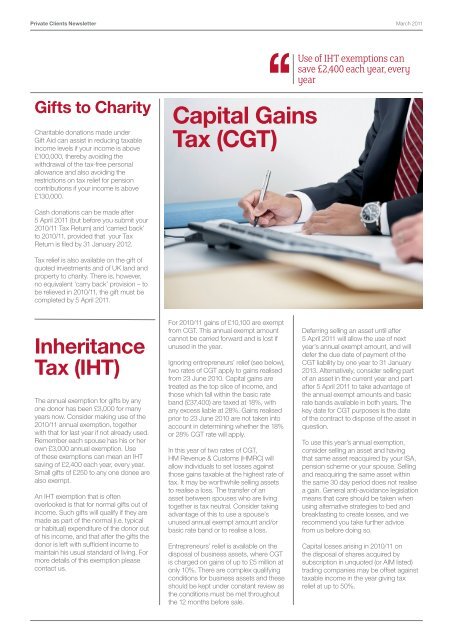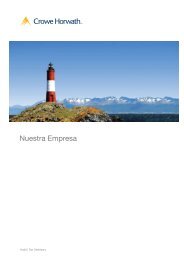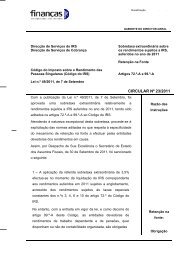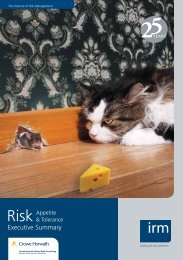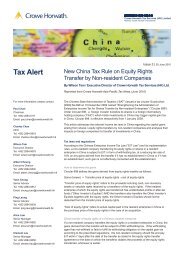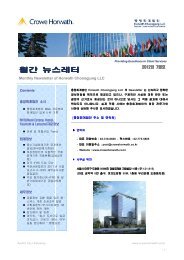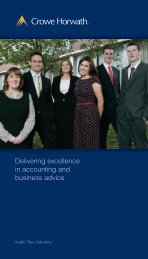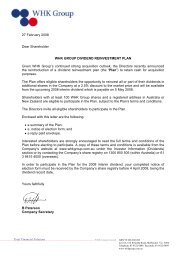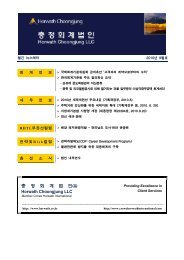March 2011 - Crowe Horwath International
March 2011 - Crowe Horwath International
March 2011 - Crowe Horwath International
Create successful ePaper yourself
Turn your PDF publications into a flip-book with our unique Google optimized e-Paper software.
Private Clients Newsletter <strong>March</strong> <strong>2011</strong><br />
Use of IHT exemptions can<br />
save £2,400 each year, every<br />
year<br />
Gifts to Charity<br />
Charitable donations made under<br />
Gift Aid can assist in reducing taxable<br />
income levels if your income is above<br />
£100,000, thereby avoiding the<br />
withdrawal of the tax-free personal<br />
allowance and also avoiding the<br />
restrictions on tax relief for pension<br />
contributions if your income is above<br />
£130,000.<br />
Capital Gains<br />
Tax (CGT)<br />
Cash donations can be made after<br />
5 April <strong>2011</strong> (but before you submit your<br />
2010/11 Tax Return) and ’carried back’<br />
to 2010/11, provided that your Tax<br />
Return is filed by 31 January 2012.<br />
Tax relief is also available on the gift of<br />
quoted investments and of UK land and<br />
property to charity. There is, however,<br />
no equivalent ‘carry back’ provision – to<br />
be relieved in 2010/11, the gift must be<br />
completed by 5 April <strong>2011</strong>.<br />
Inheritance<br />
Tax (IHT)<br />
The annual exemption for gifts by any<br />
one donor has been £3,000 for many<br />
years now. Consider making use of the<br />
2010/11 annual exemption, together<br />
with that for last year if not already used.<br />
Remember each spouse has his or her<br />
own £3,000 annual exemption. Use<br />
of these exemptions can mean an IHT<br />
saving of £2,400 each year, every year.<br />
Small gifts of £250 to any one donee are<br />
also exempt.<br />
An IHT exemption that is often<br />
overlooked is that for normal gifts out of<br />
income. Such gifts will qualify if they are<br />
made as part of the normal (i.e. typical<br />
or habitual) expenditure of the donor out<br />
of his income, and that after the gifts the<br />
donor is left with sufficient income to<br />
maintain his usual standard of living. For<br />
more details of this exemption please<br />
contact us.<br />
For 2010/11 gains of £10,100 are exempt<br />
from CGT. This annual exempt amount<br />
cannot be carried forward and is lost if<br />
unused in the year.<br />
Ignoring entrepreneurs’ relief (see below),<br />
two rates of CGT apply to gains realised<br />
from 23 June 2010. Capital gains are<br />
treated as the top slice of income, and<br />
those which fall within the basic rate<br />
band (£37,400) are taxed at 18%, with<br />
any excess liable at 28%. Gains realised<br />
prior to 23 June 2010 are not taken into<br />
account in determining whether the 18%<br />
or 28% CGT rate will apply.<br />
In this year of two rates of CGT,<br />
HM Revenue & Customs (HMRC) will<br />
allow individuals to set losses against<br />
those gains taxable at the highest rate of<br />
tax. It may be worthwhile selling assets<br />
to realise a loss. The transfer of an<br />
asset between spouses who are living<br />
together is tax neutral. Consider taking<br />
advantage of this to use a spouse’s<br />
unused annual exempt amount and/or<br />
basic rate band or to realise a loss.<br />
Entrepreneurs’ relief is available on the<br />
disposal of business assets, where CGT<br />
is charged on gains of up to £5 million at<br />
only 10%. There are complex qualifying<br />
conditions for business assets and these<br />
should be kept under constant review as<br />
the conditions must be met throughout<br />
the 12 months before sale.<br />
Deferring selling an asset until after<br />
5 April <strong>2011</strong> will allow the use of next<br />
year’s annual exempt amount, and will<br />
defer the due date of payment of the<br />
CGT liability by one year to 31 January<br />
2013. Alternatively, consider selling part<br />
of an asset in the current year and part<br />
after 5 April <strong>2011</strong> to take advantage of<br />
the annual exempt amounts and basic<br />
rate bands available in both years. The<br />
key date for CGT purposes is the date<br />
of the contract to dispose of the asset in<br />
question.<br />
To use this year’s annual exemption,<br />
consider selling an asset and having<br />
that same asset reacquired by your ISA,<br />
pension scheme or your spouse. Selling<br />
and reacquiring the same asset within<br />
the same 30 day period does not realise<br />
a gain. General anti-avoidance legislation<br />
means that care should be taken when<br />
using alternative strategies to bed and<br />
breakfasting to create losses, and we<br />
recommend you take further advice<br />
from us before doing so.<br />
Capital losses arising in 2010/11 on<br />
the disposal of shares acquired by<br />
subscription in unquoted (or AIM listed)<br />
trading companies may be offset against<br />
taxable income in the year giving tax<br />
relief at up to 50%.


